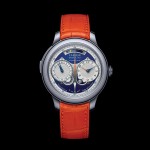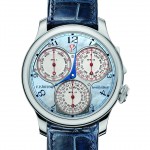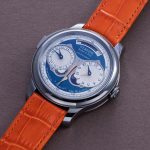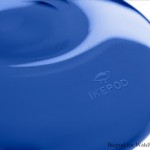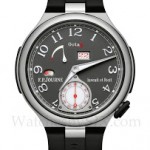In-Depth: F.P. Journe FFC Blue “Francis Ford Coppola”
Exceptional and intriguing.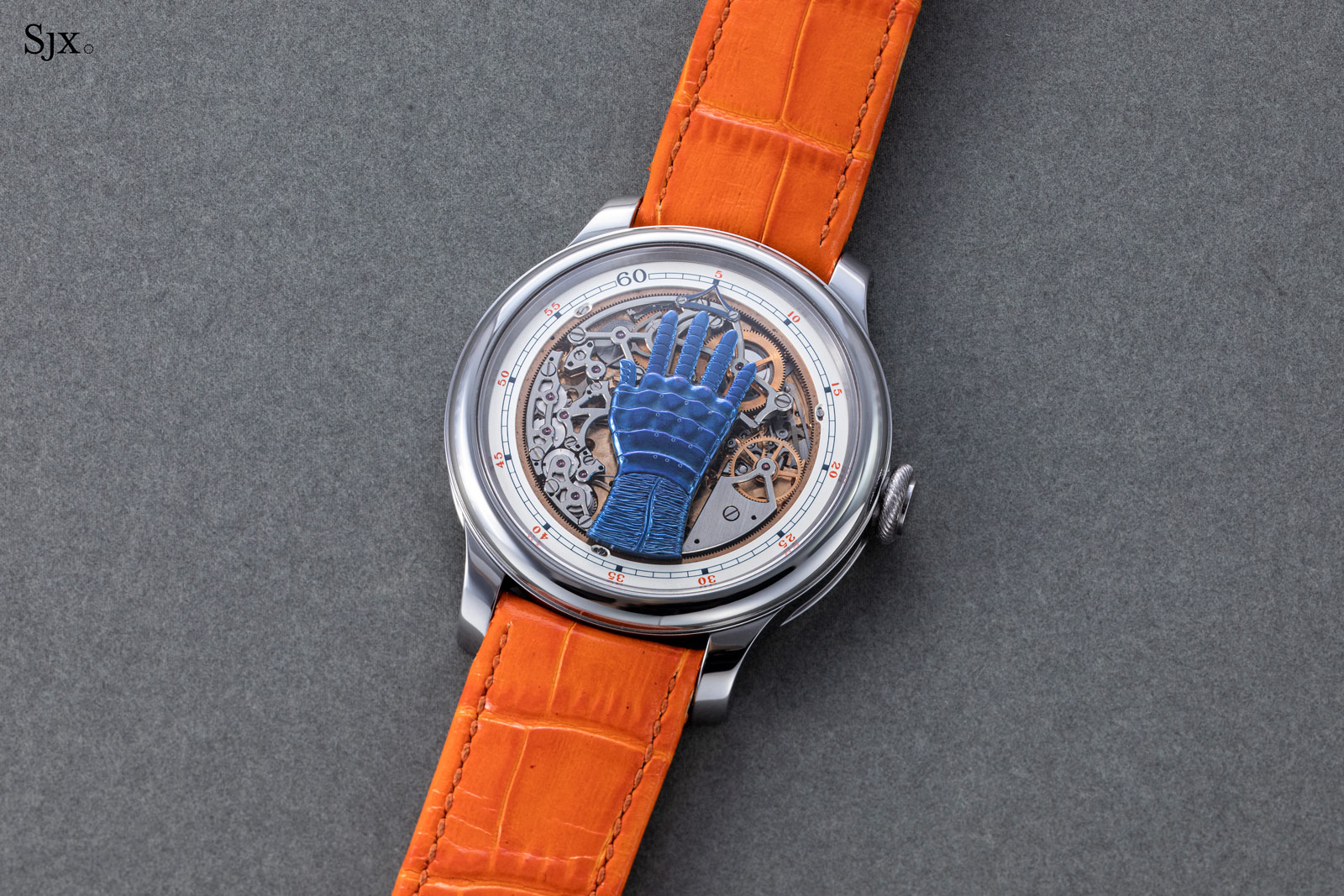
Francois-Paul Journe’s creation for Only Watch 2021, the F.P. Journe FFC Blue, sticks to a familiar template. Like prior watches conceived for the biennial charity auction – the tourbillon of 2015, split-seconds chronograph of 2017, and the Astronomic of 2019 – this year’s timepiece has a tantalum case and blue dial.
But FFC Blue is a strikingly unique watch – the five-fingered time display is a first in watchmaking. Though it has a conventional round case, the FFC Blue is conceptually closer to the unconventional Vagabondage watches than the brand’s round watches.
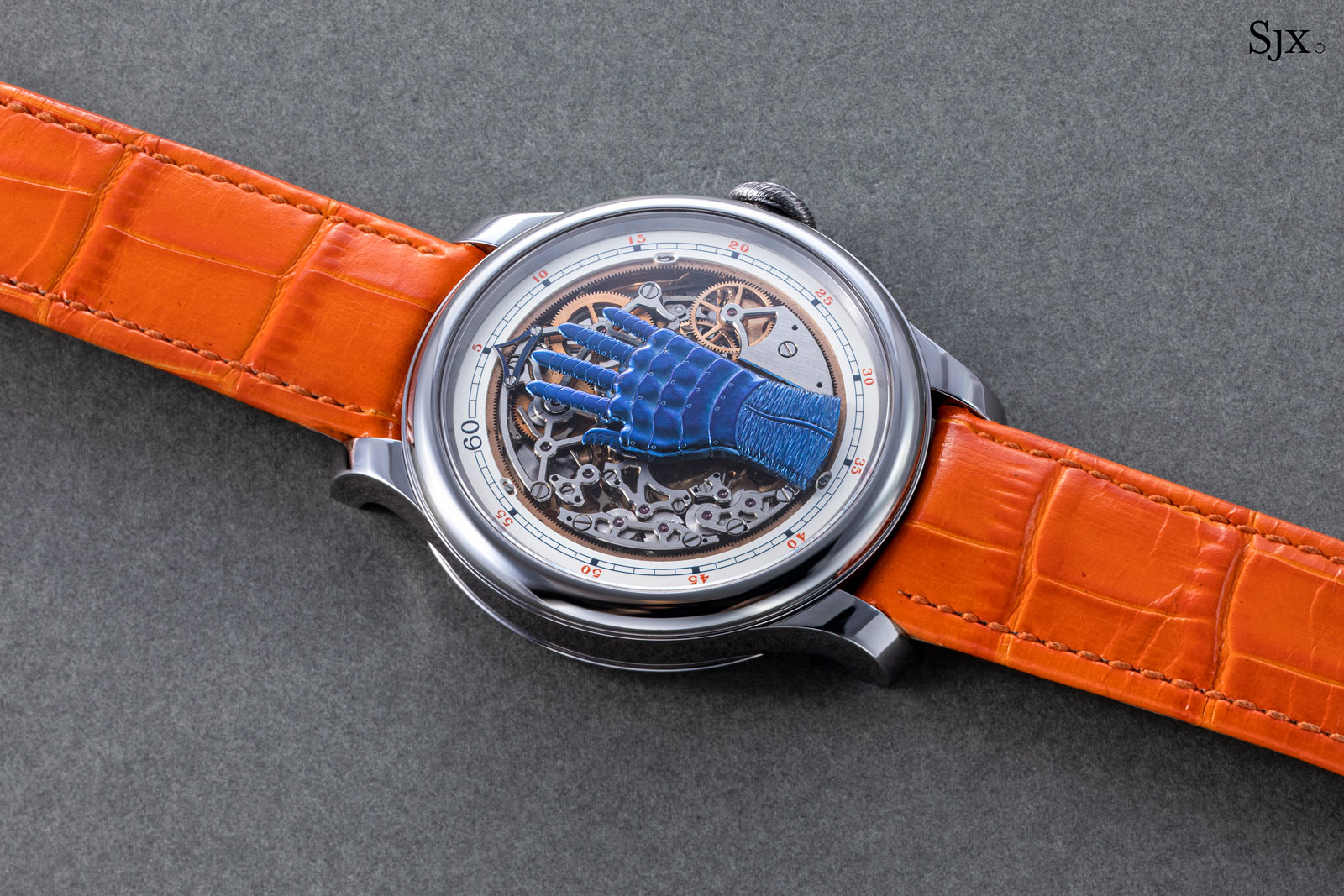
Short for Francis Ford Coppola, the FFC Blue originated with a question posed to Mr Journe by the director of The Godfather and Apocalypse Now in 2012. Mr Coppola suggested a watch that indicated the time with human hand.
Over the following years Mr Journe worked on the concept, with Mr Coppola suggesting the finger positions to indicate each hour. And now the filmmaker’s idea has been realised as a one-off creation for the charity auction.
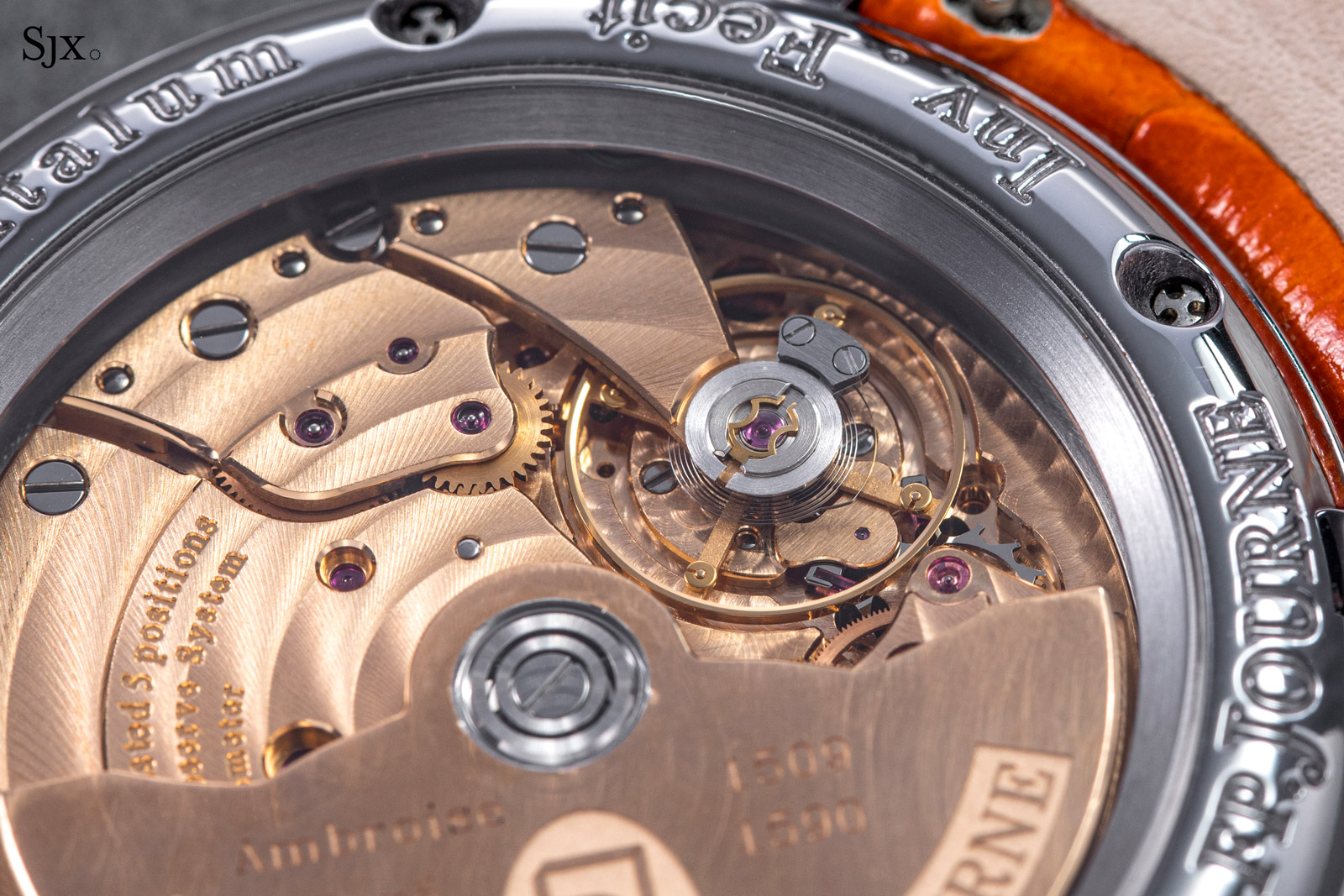
Though entirely unique compared with F.P. Journe’s other creations, the FFC is powered by the workhorse cal. 1300 of the Octa series
Initial thoughts
I found the hand-display concept intensely compelling when Mr Journe described it during my visit to Geneva in 2017. In the metal the FFC is equally compelling. It is inventive and appealing.
It’s rather large at 42 mm in diameter, though like nearly all F.P. Journe watches it is unusually thin given the complication. The diameter is a perfect canvas for the arresting dial that immediately captures the attention. There is nothing else like it on the market.
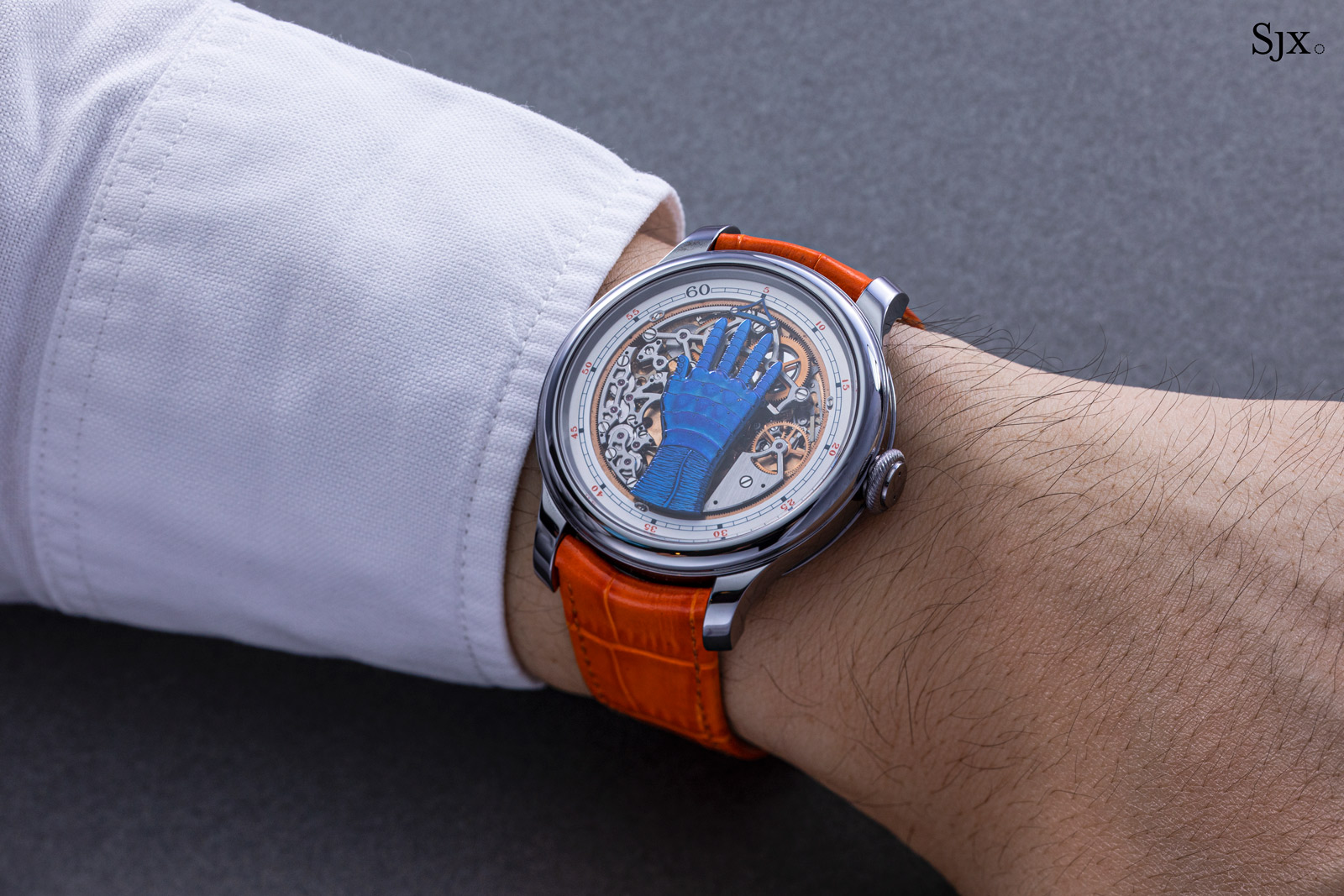
Although the dial is dominated by the blue hand that resembles a metallic glove – the hand based on a 16th century anatomical model – it is densely complex due to the exposed mechanism.
The mass of cams, wheels, and springs that drive the hand, which is essentially an ultra-elaborate jumping hour, are impressive in their complexity. That said, some parts of it aren’t particularly pretty, especially in how the bridges are skeletonised.
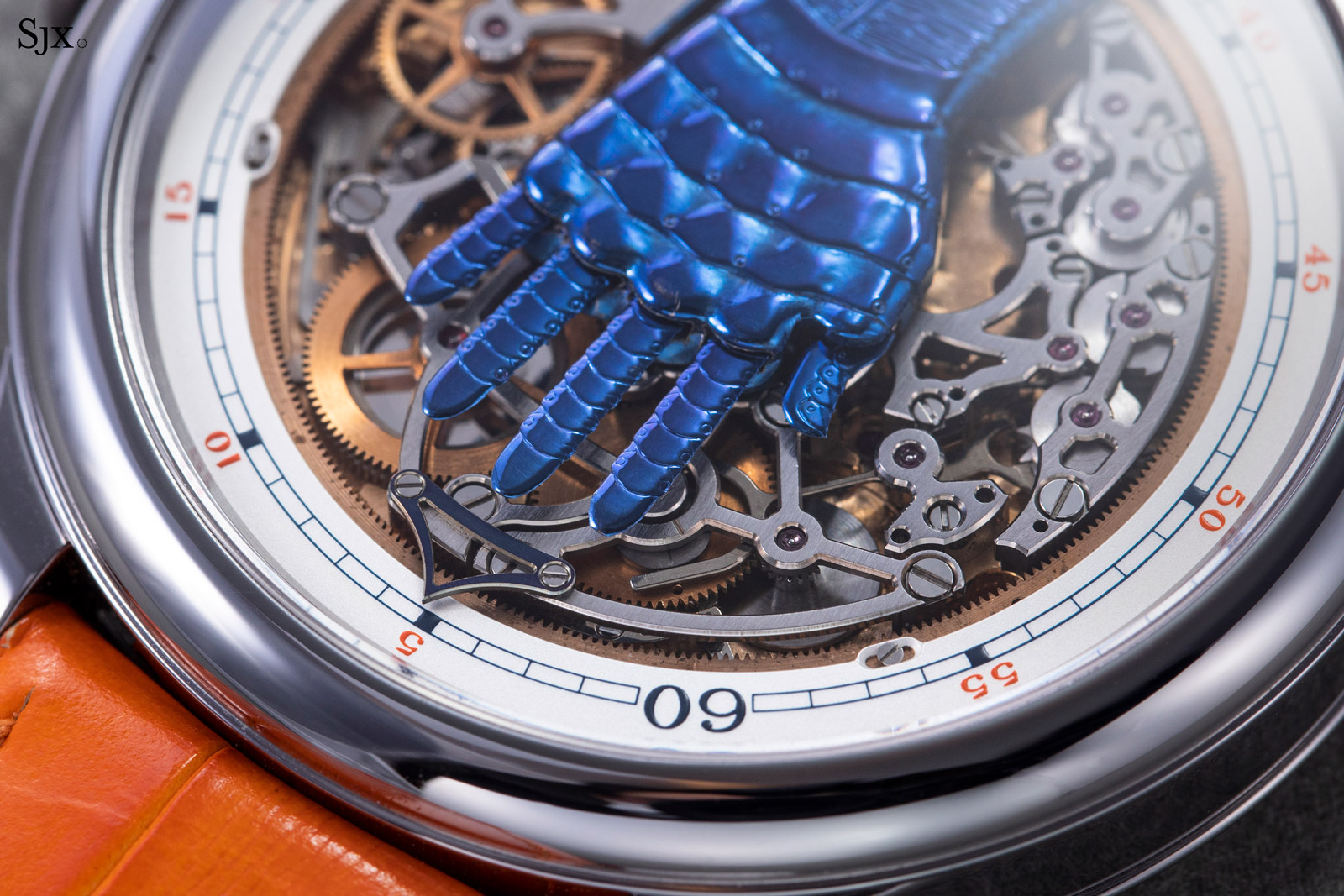
The FFC Blue has an estimate of CHF300,000-400,000, but I expect it’ll go for 10 times the estimate. Certainly deserving of the acclaim and value, the FFC Blue will raise a handsome sum for a worthy cause.
But at the same time, the FFC Blue’s value also reflects the frenzied demand for F.P. Journe watches, and a broader, undiscerning fad for independent watchmaking.
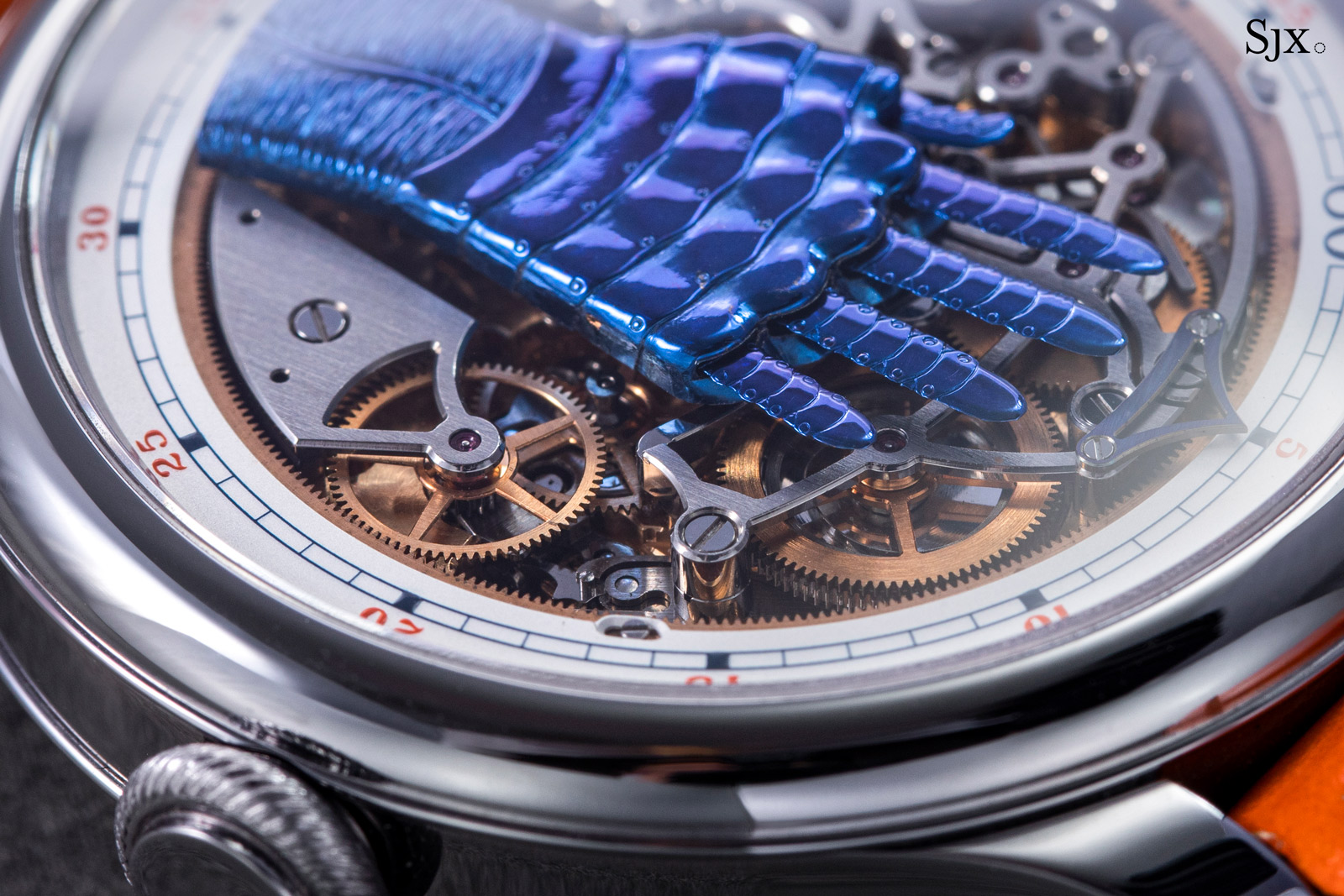
Paré’s invention
The display is centred on the blue hand, which is inspired by a mechanical, prosthetic hand invented by Ambroise Paré (1509-1590), a French barber surgeon who pioneered several surgical techniques and battlefield treatments.
Built in 1551, Le Petit Lorrain, as Paré’s hand was known, relied on levers and springs to mimic the movements of a real hand. It was apparently worn by a French cavalry captain into battle, who reported he was able to grip the reins of his horse with the hand.
The hand of the FFC Blue reproduces the joints and rivets of Paré’s invention. And it is also similar conceptually to the surgeon’s prosthetic – the hand of the FFC Blue is a mechanical invention devised to complete a single task.
Here it’s employed to indicate the hours via raised fingers. Five individual fingers extend and retract to indicate the hours from one to 12.
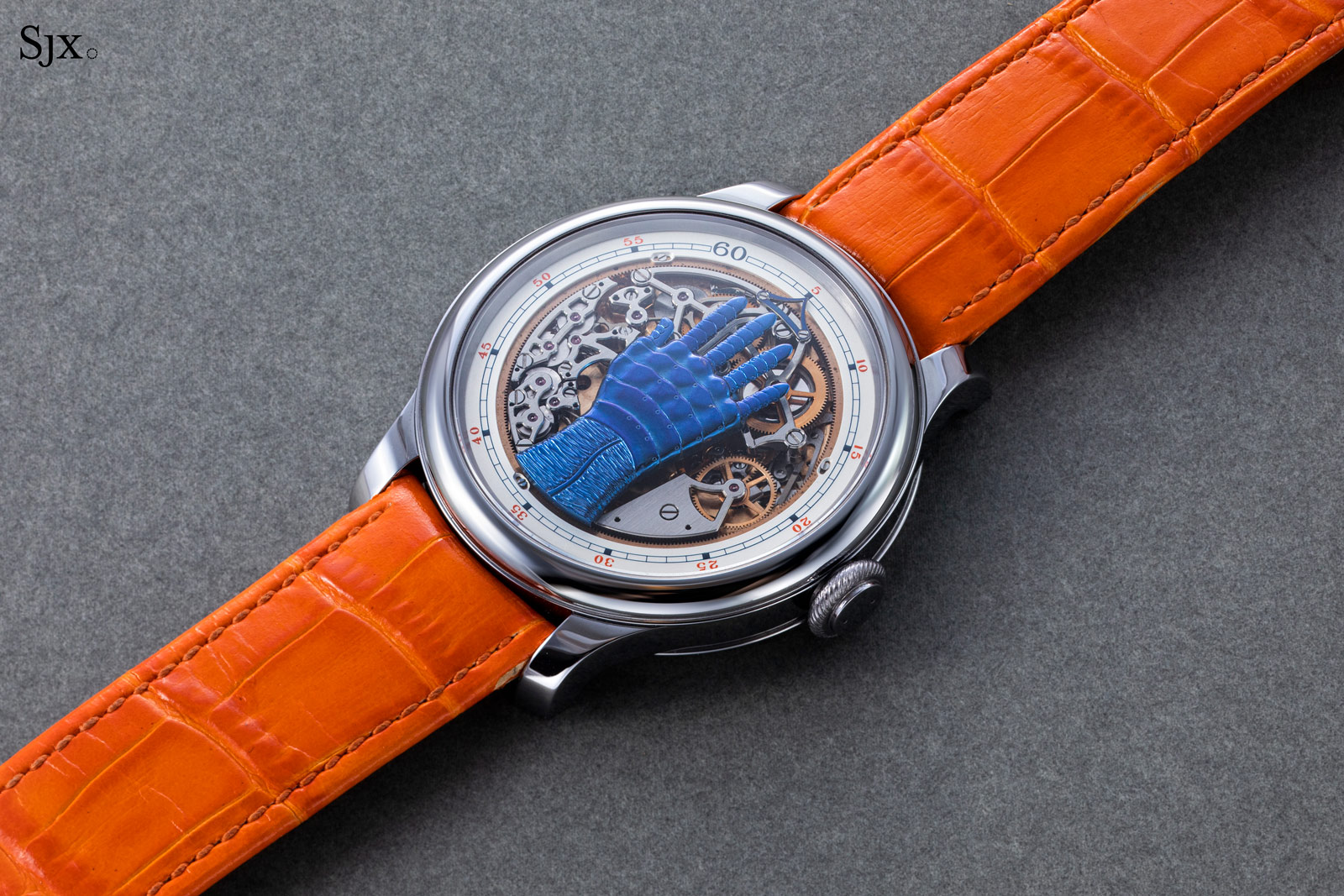
From one to five the display is obvious, and then it gets more creative from six onwards
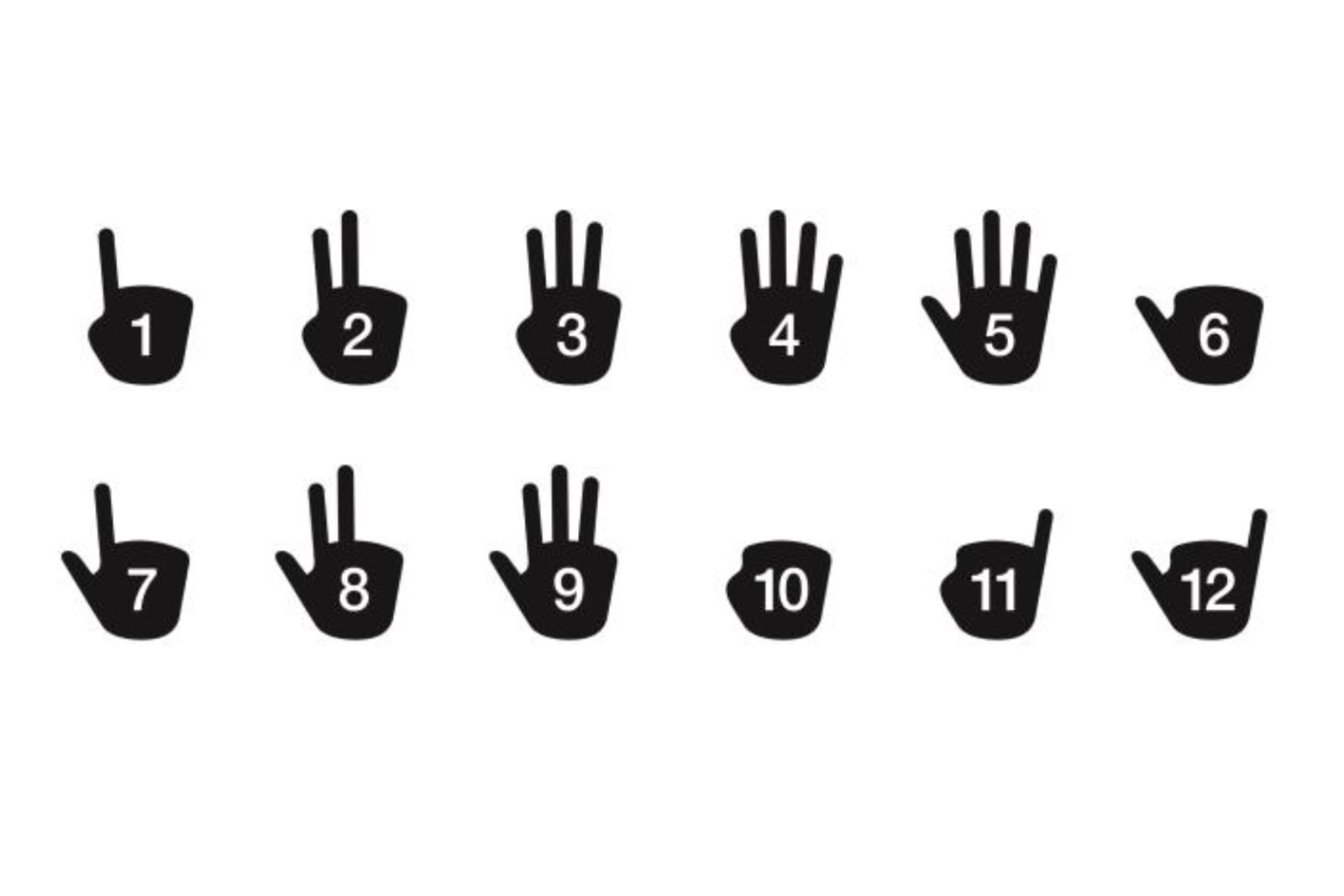
Because the hand can only display one to 12, the hand runs through the entire cycle twice a day
As an aside, it would be theoretically possible to display up to 32 different digits on a single hand, as five fingers extended or retracted – five binary digits – would make for 2^5=32 combinations. So it would be possible to display up to 24 hours on one hand, but that would be too cumbersome to accomplish, and equally importantly, impractical to read given the need to remember the 24 combinations.
Mechanics explained
Each of the fingers is controlled by the mechanism visible on the left side of the dial, which is connected to the fingers via fine mechanical linkages acting as levers. Though F.P. Journe is tight-lipped as to how exactly the mechanism works, there is enough exposed on the dial to deduce its basic principles.
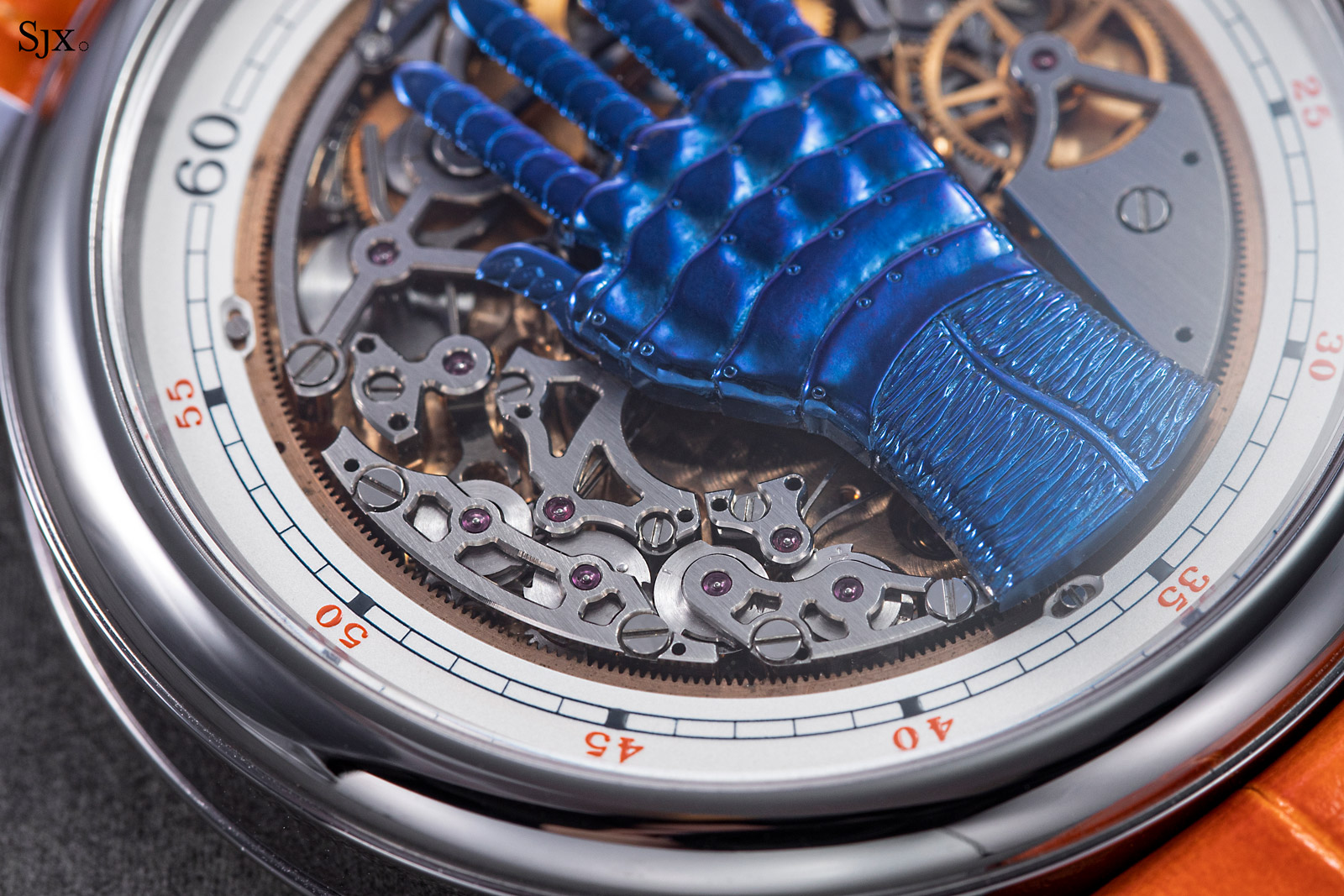
Between seven and nine o’clock on the dial, four cams are visible – but the number of cams is actually double, because each is actually a pair of stacked cams. These stacked cams are geared together, with each pair rotating once every hour.
Each cam is essentially a mechanical programme that encodes the motion of each finger, either extension or retraction, actuating the individual connections to move the fingers. The reason that there are four pairs, instead of five, is because the thumb simply pivots inward or outwards, so no cam is required for its motion.
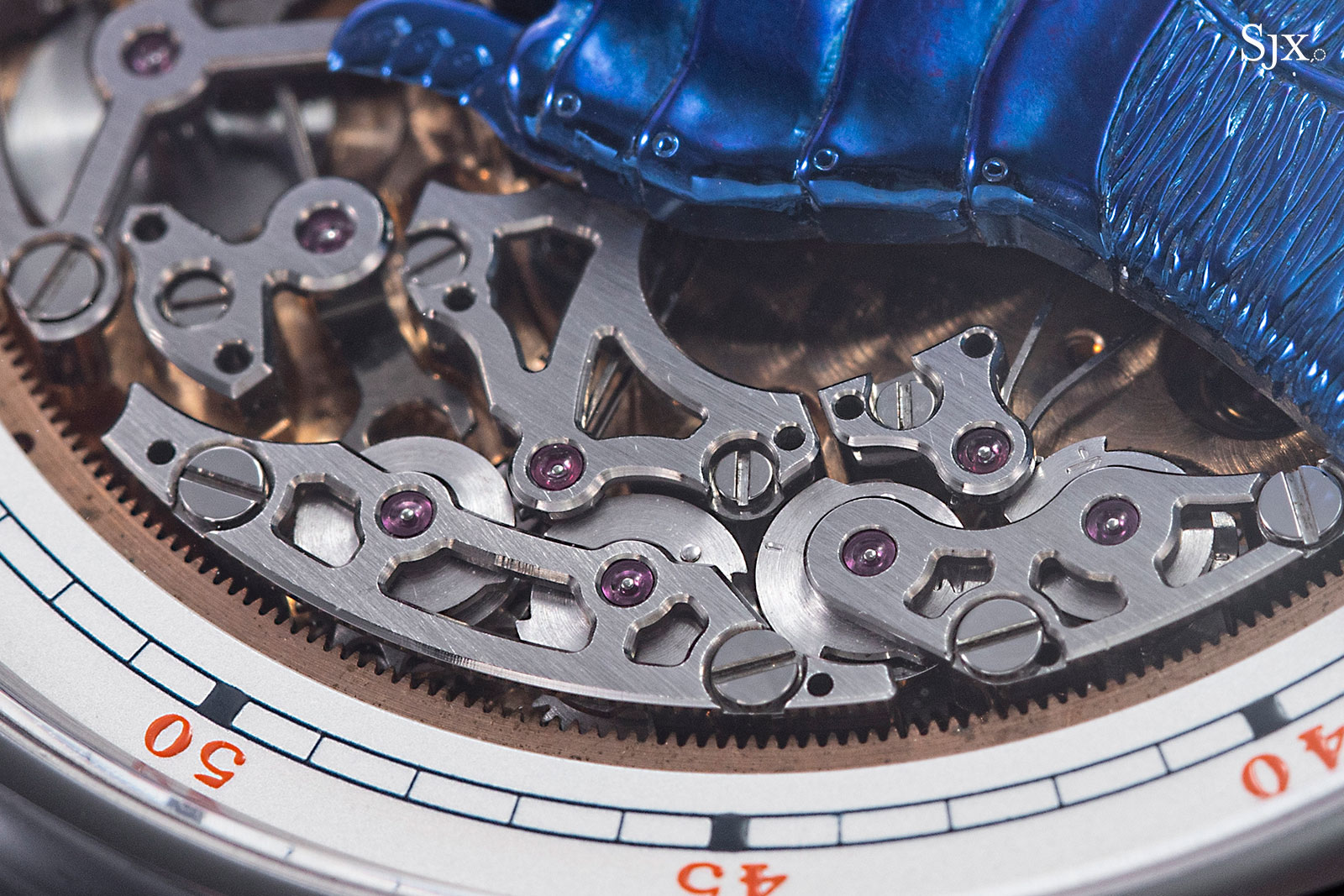
The cams arranged in a line along the edge of the dial
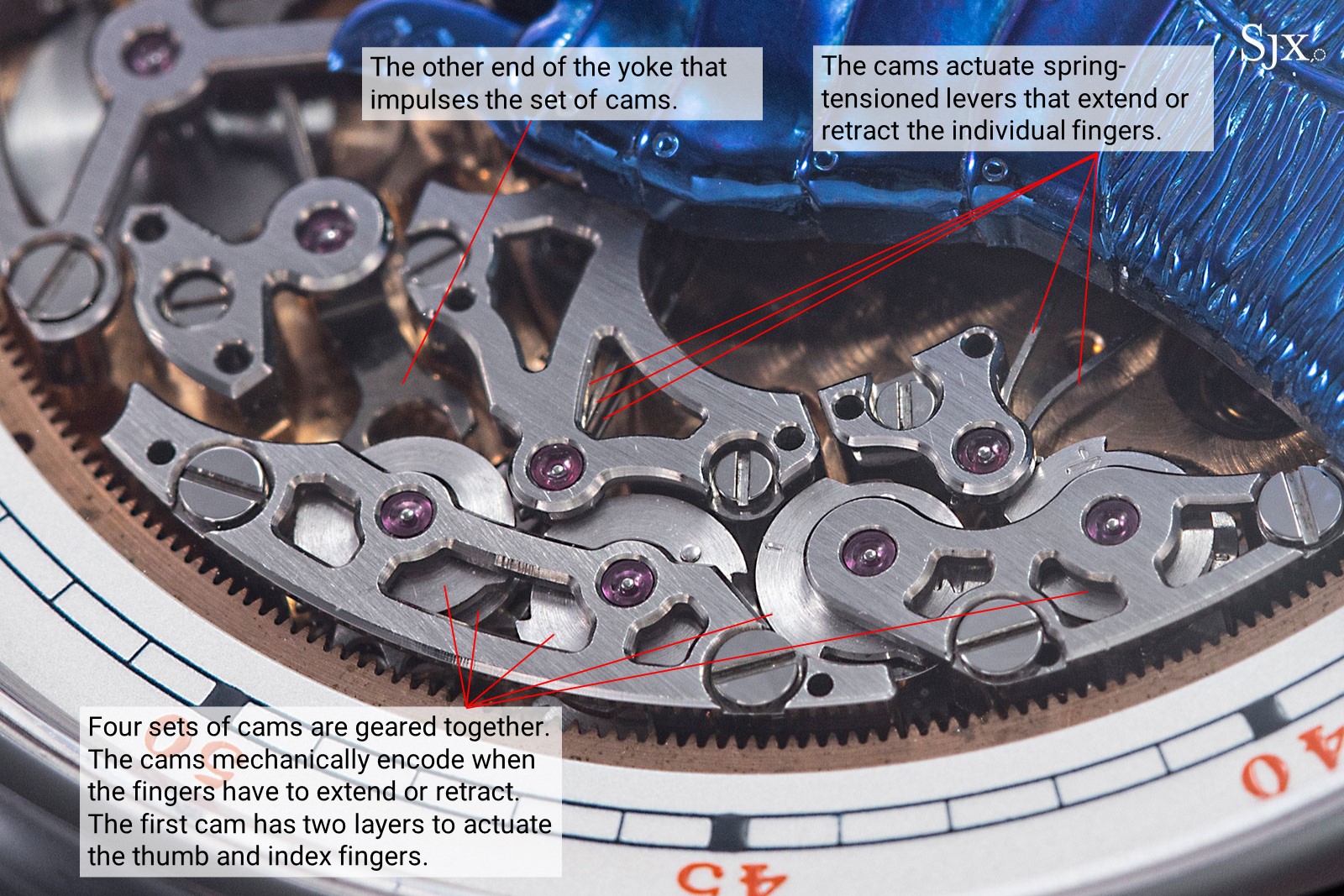
The cams are located a distance away from the hand – a mechanical necessity as the distance allows for a wider, sweeping motion of the mechanical linkages. That degree of travel is required to extend and retract the fingers. At the same time, the pivots of the linkages are located close to the respective cams to obtain the necessary geometry of the pivoting action.
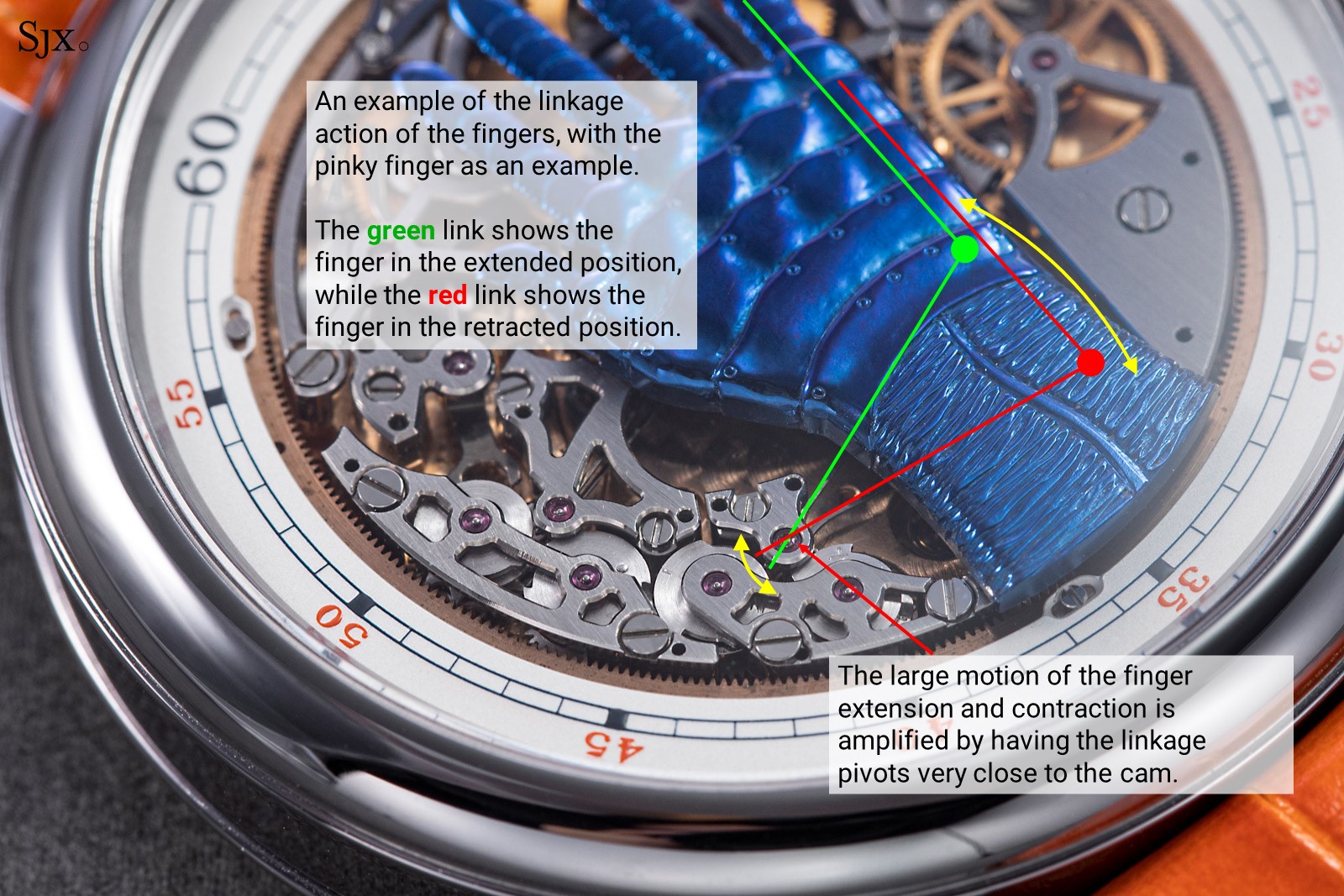
The cams have to be impulsed within a split second to facilitate an instantaneous jump of the fingers. To achieve this, the cams are driven by a long yoke, essentially a prong with a U-shaped end, which is positioned diagonally across the movement from 12 to ten o’clock.
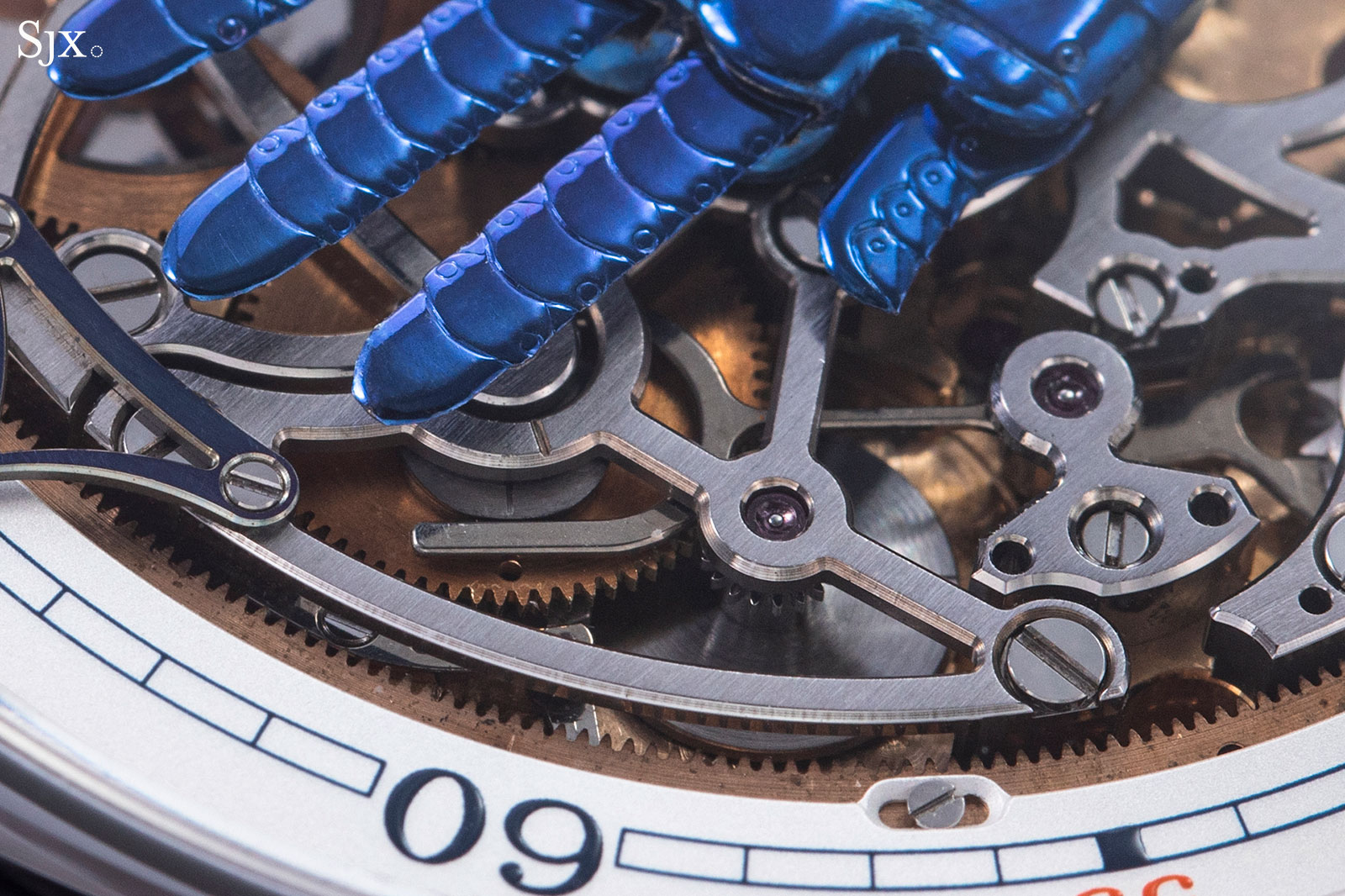
The end of the yoke is visible just below the index finger
The yoke in turn, is driven via an eccentric cam centred between its prongs. The eccentric cam is driven via a buffer spring that resembles an open-worked mainspring barrel. Energy is stored in the buffer spring and instantaneously released at the top of every hour, which causes the jump of the yoke.
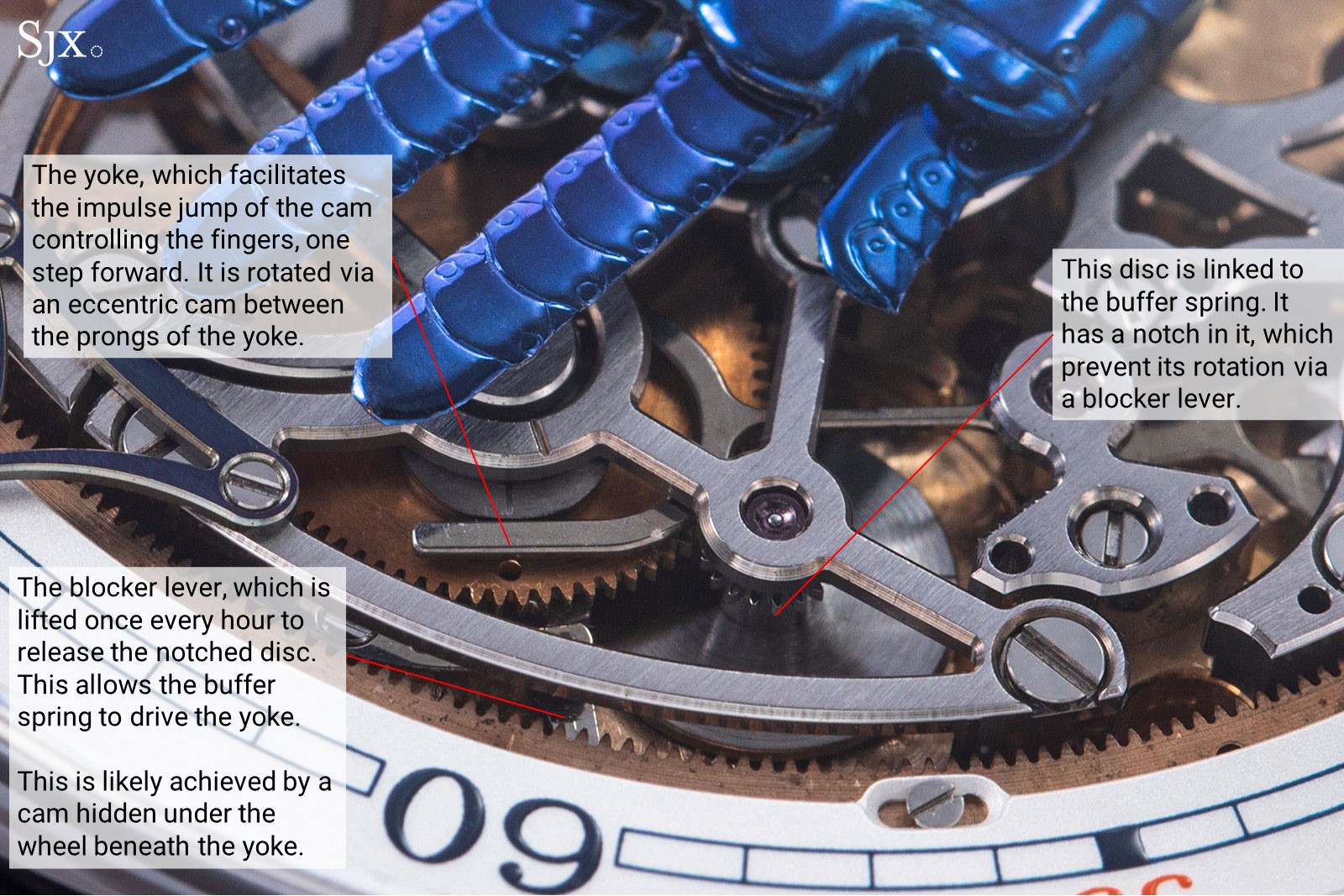
The eccentric cam driving the yoke which impulses the finger cams. A blocker lever releases the mechanism once every hour to facilitate the instantaneous jump.
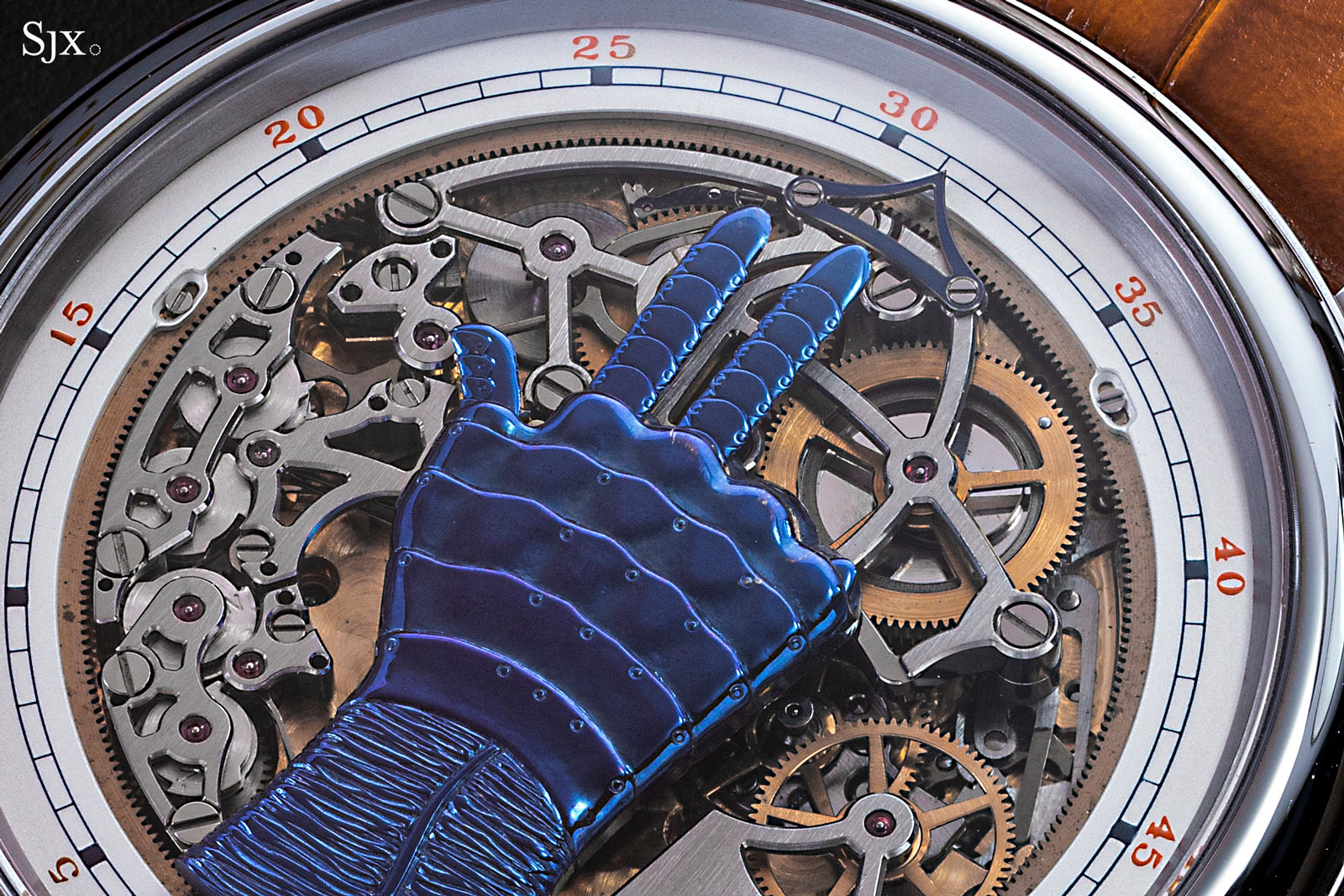
The buffer spring is driven off the centre wheel at three o’clock, located deep down and just to the right of the blue hand. The centre wheel, which rotates once an hour, is continuously driven by the movement and drives both the buffer spring and the minute ring display that will be explained below.
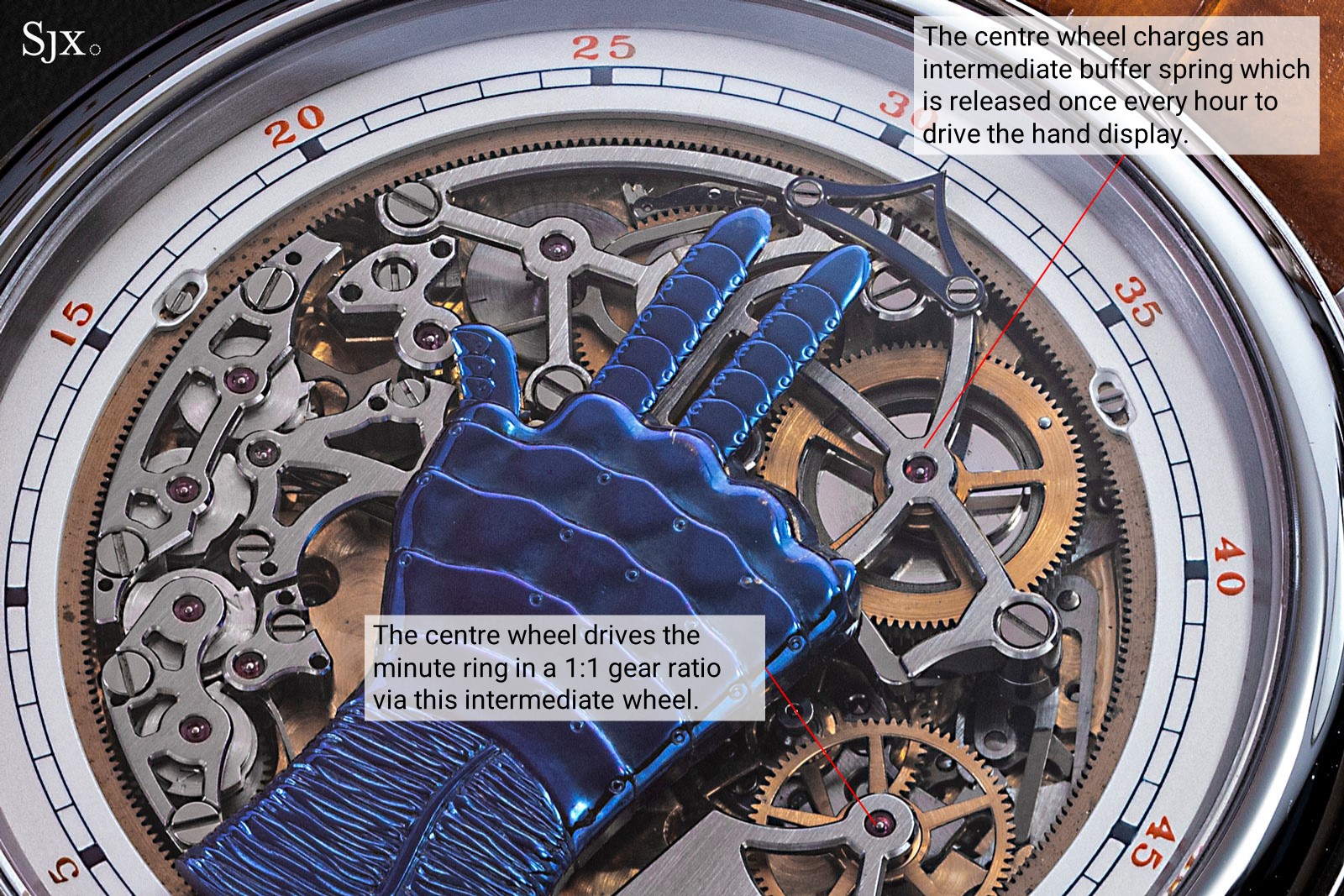
The eagle-eyed will notice that the centre wheel is exactly at the location of the off-centred, time-display sub-dials on most Octa models. In other words, the hand indicator continues where the time display ends off on the standard Octa models.
And that’s because the FFC is powered by the same cal. 1300 found in the Octa. It is an unconventional automatic movement, because it has an unusually large mainspring barrel. The barrel is wider than the radius of the movement (of half its diameter), which is possible thanks to the off-centred centre wheel.
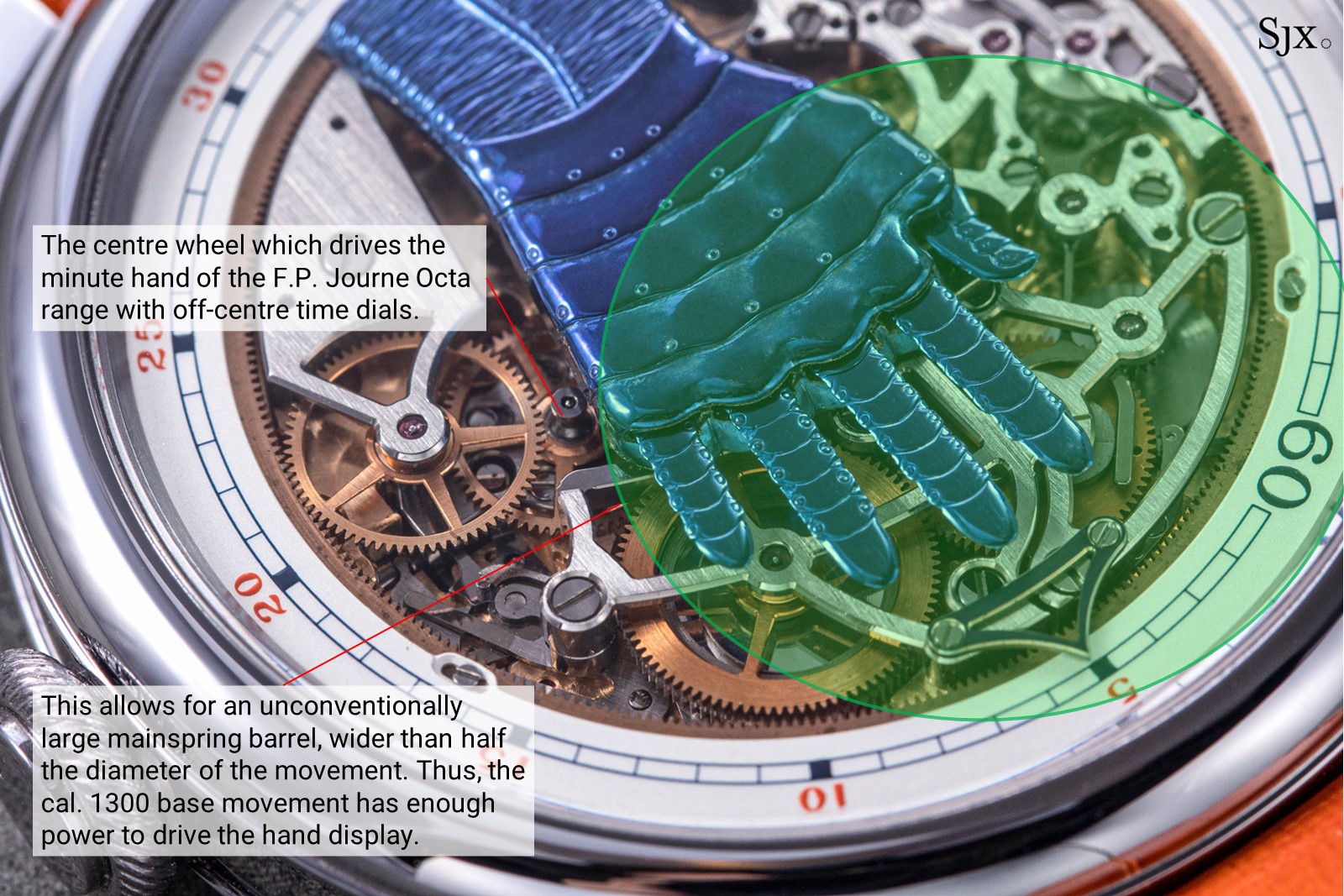
The off-centred centre wheel allows for a larger than average mainspring barrel
The size of the barrel also explains the cal. 1300’s lengthy five-day power reserve (which was originally envisioned to be eight days by Mr Journe but it was an ambition that proved unfeasible then).
Conveniently, this also means that the mainspring barrel has sufficient power to drive the power-hungry instantaneous jump of the hand display.
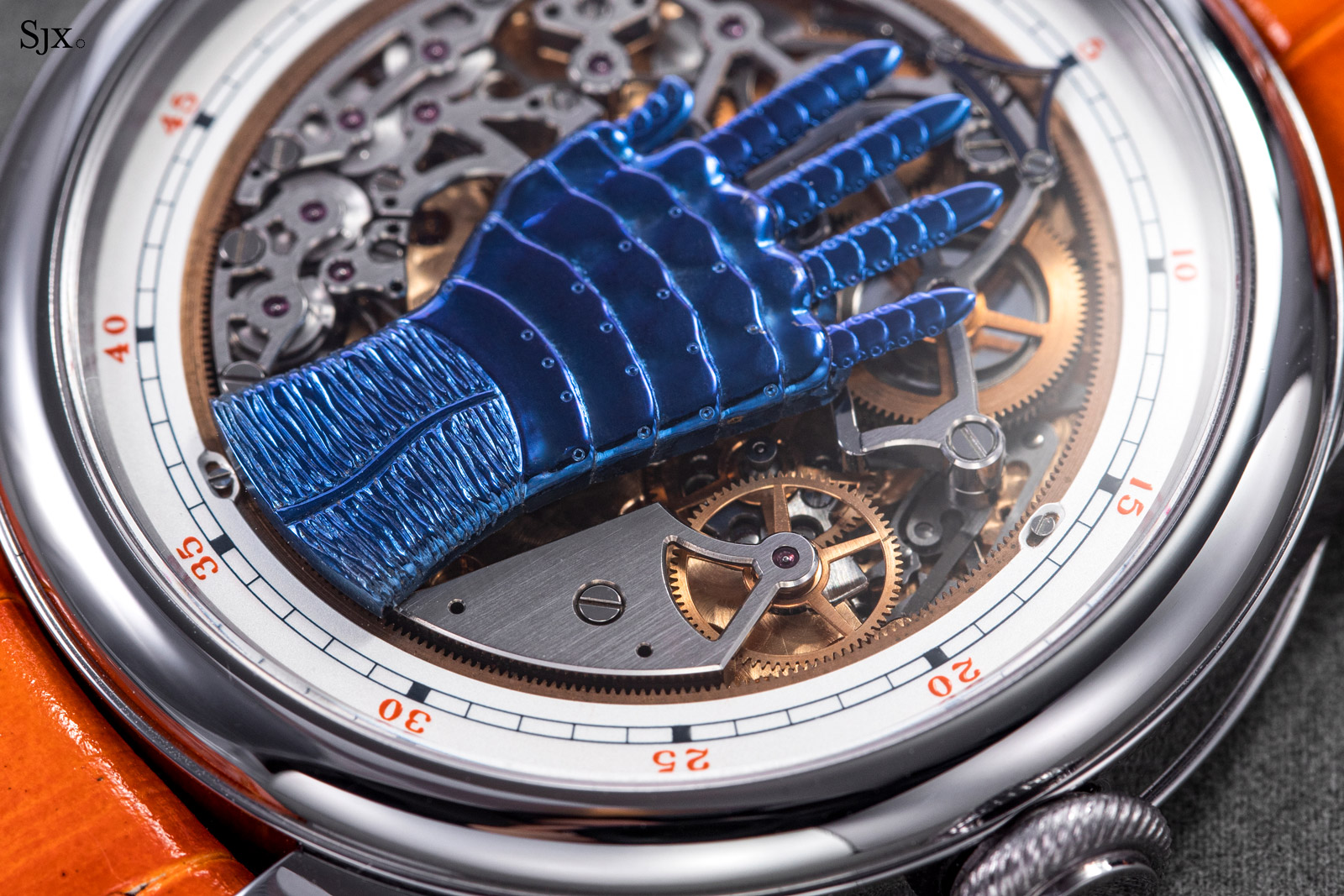
Since the hand occupies the entire centre of the dial, a peripheral, rotating disc is called into service to indicate the minutes. This is a continuously rotating ring, which rotates anti-clockwise once every hour – driven via an additional wheel at three o’clock that is secured by a large, wedge-shaped bridge.
An open-worked arrow is fixed at 12 o’clock, and indicates the minutes against the rotating minute ring.
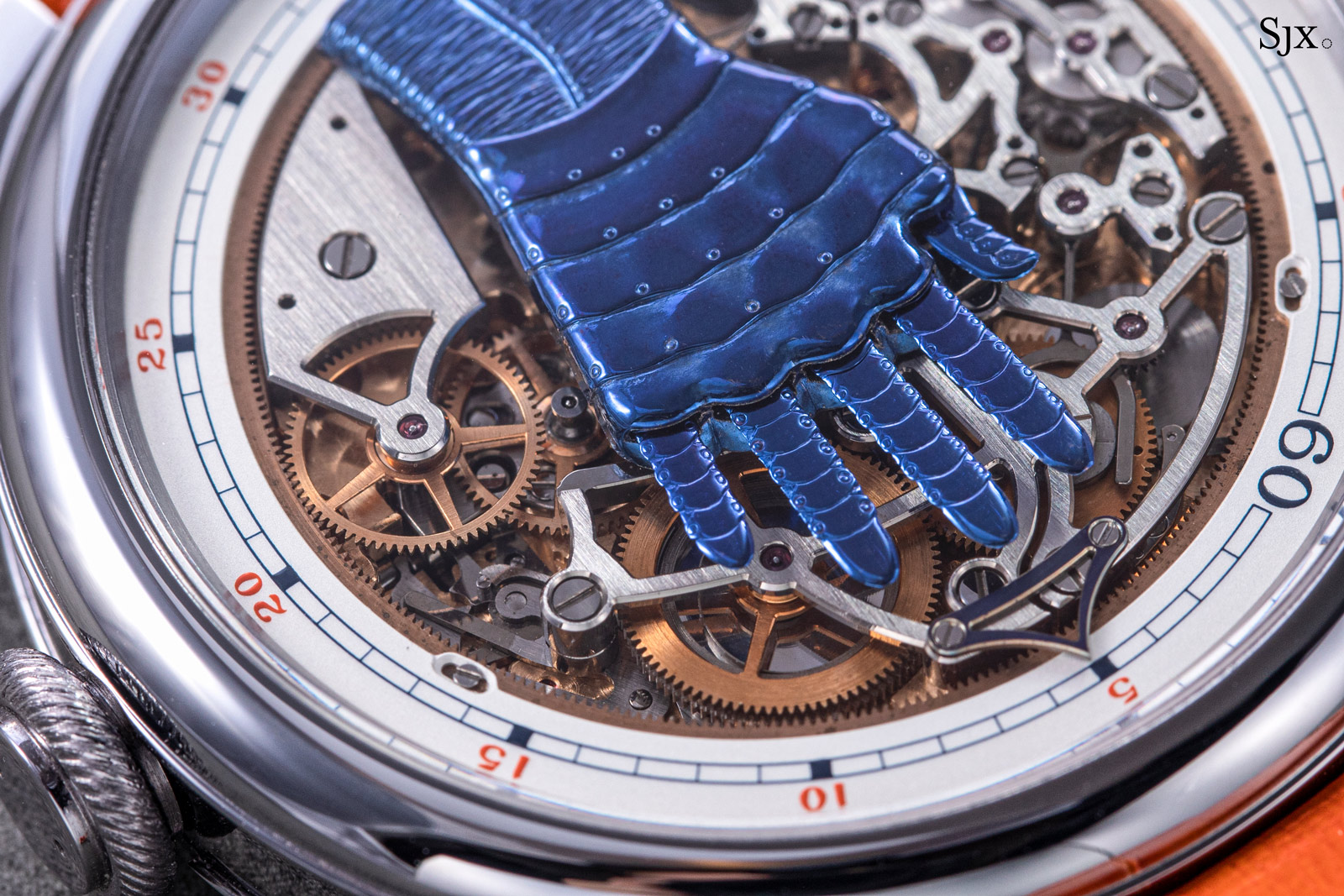

A familiar calibre
The hand display is basically an additional mechanism on top of the cal. 1300 base movement, which is the workhorse calibre found across the Octa range. It is well suited to power the hand display thanks to its large mainspring barrel.
The movement is characterised by its peculiar rotor, which is slightly smaller than the movement diameter and positioned off-centre, closer to the crown. The view of the FFC from the back is identical to a typical Octa model with a red-gold movement, save for the off-centre rotor, which is customised for the FFC Blue.
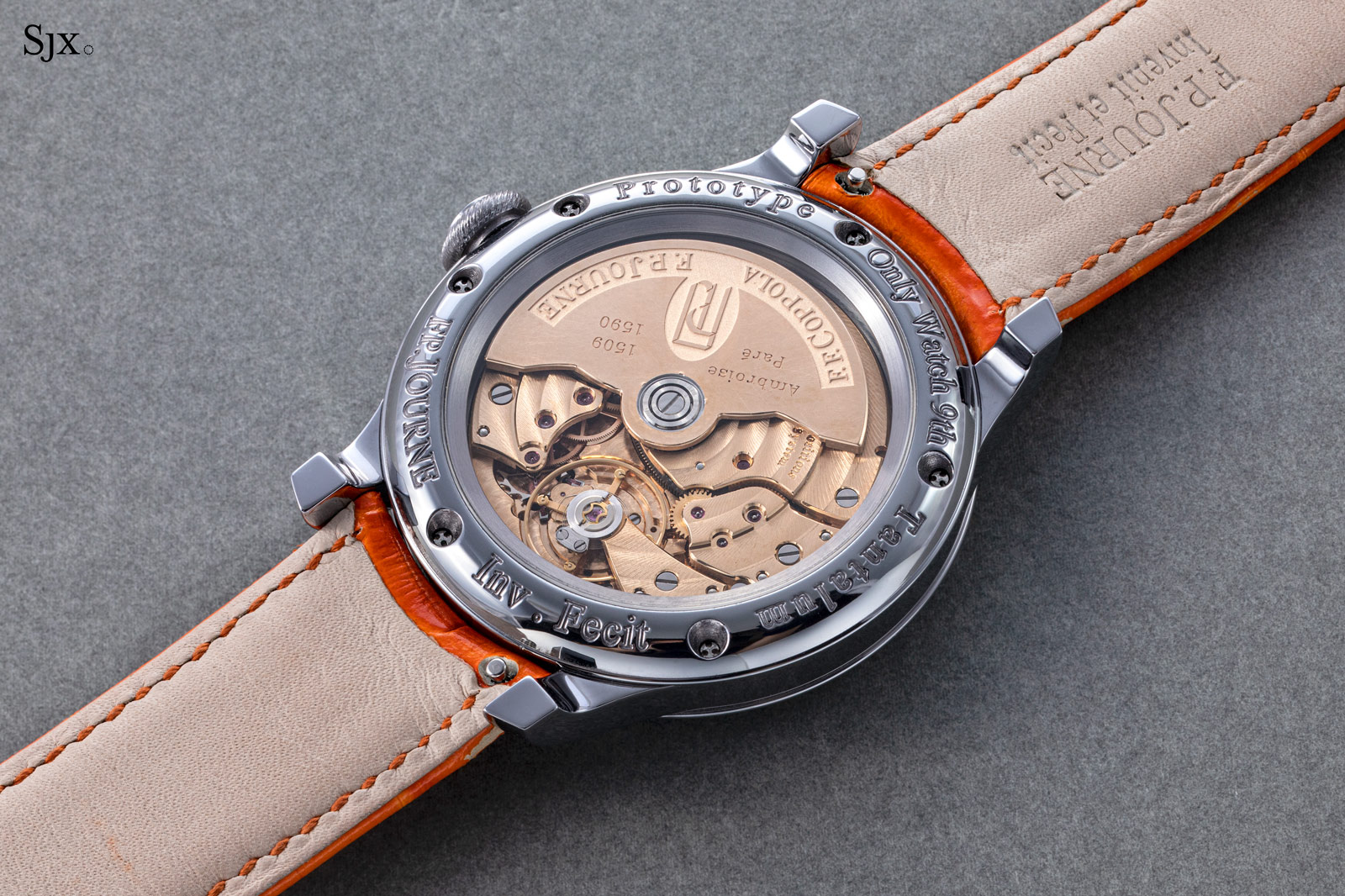
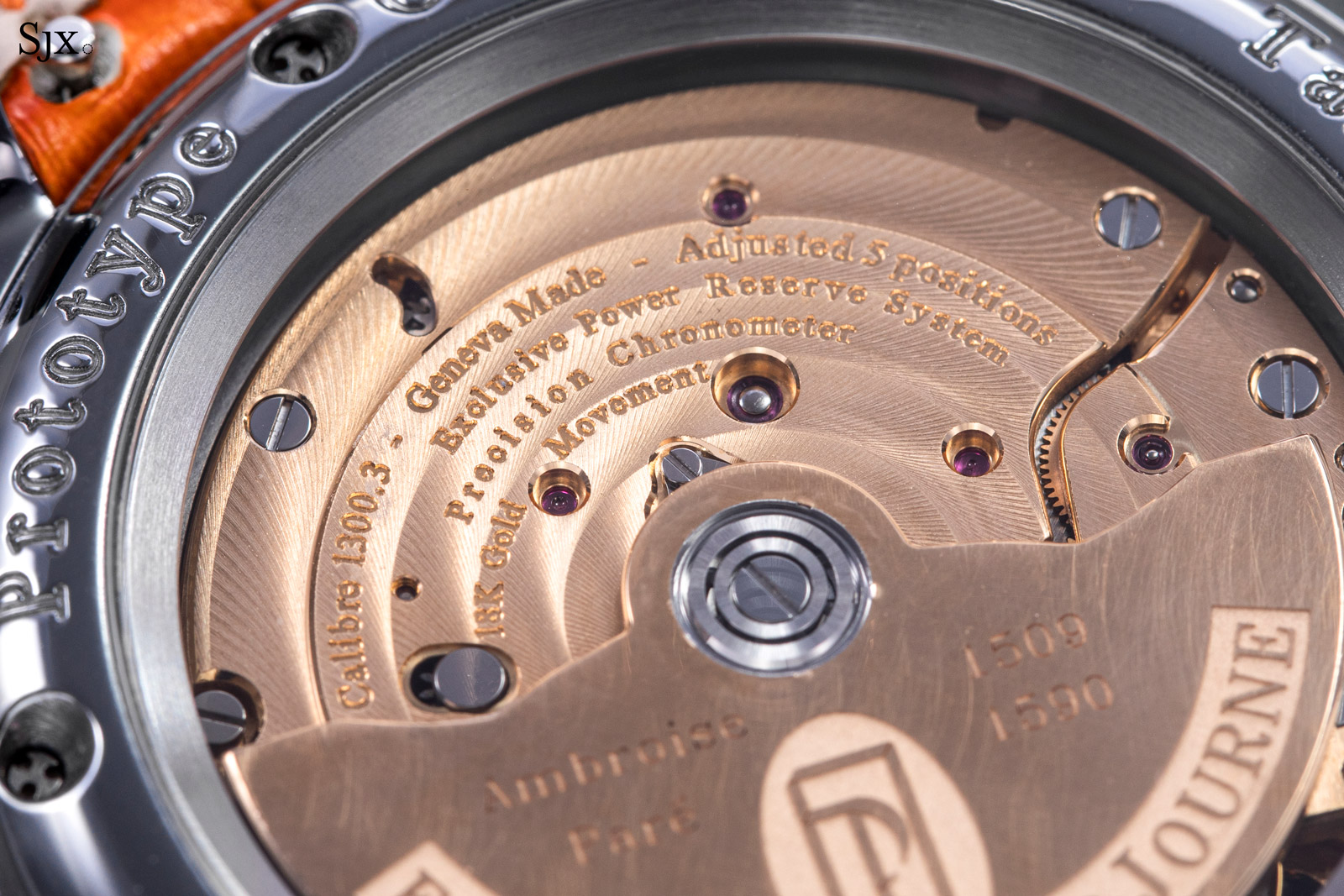

As with past Only Watch editions, the FFC Blue is a prototype – literally. Consequently, the custom rotor has all the scuffs and scratches one would expect on a prototype that was worked on for a long period of time.
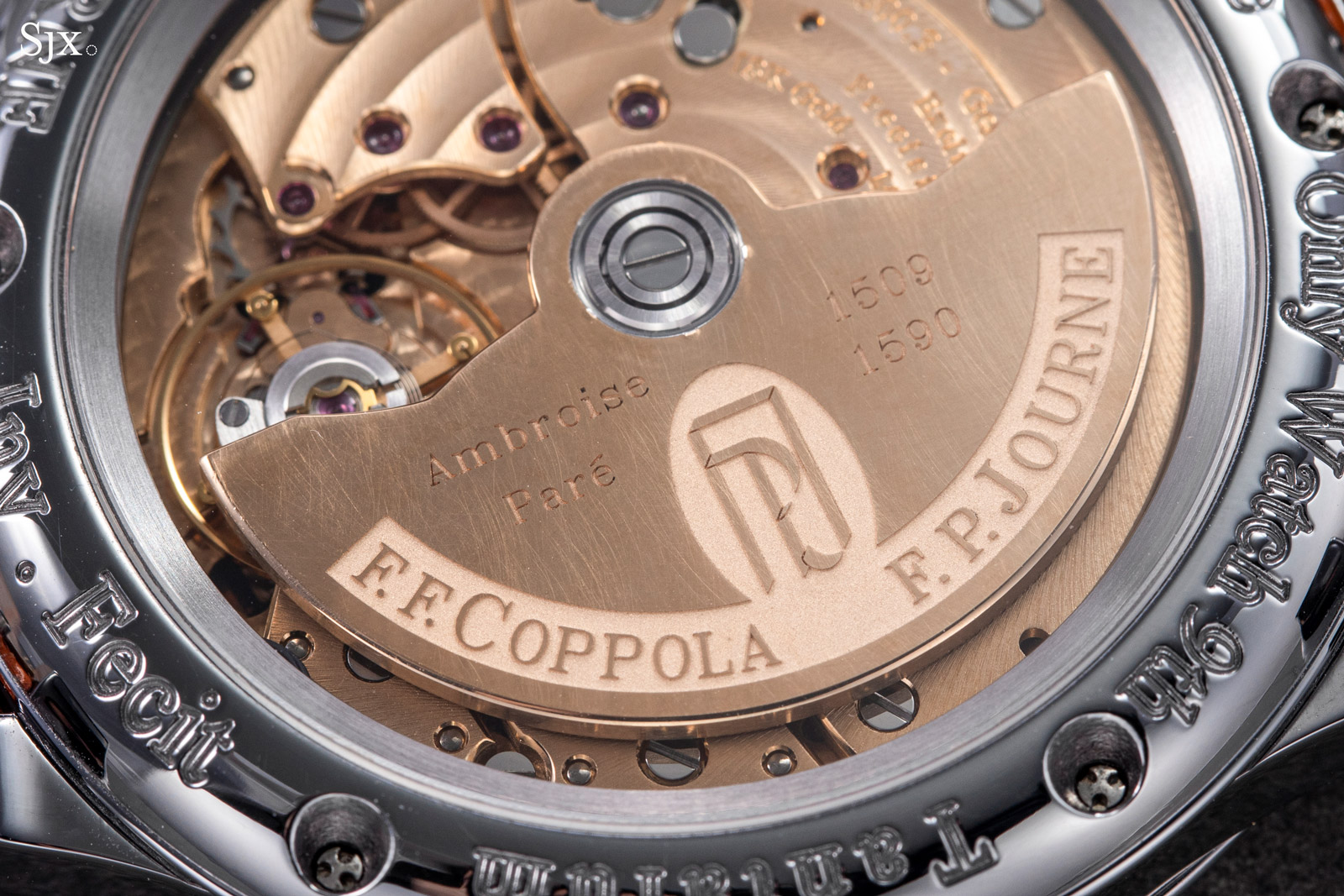
The rotor includes the names of Mr Coppola and Paré, as well as the the years of Paré’s birth and death
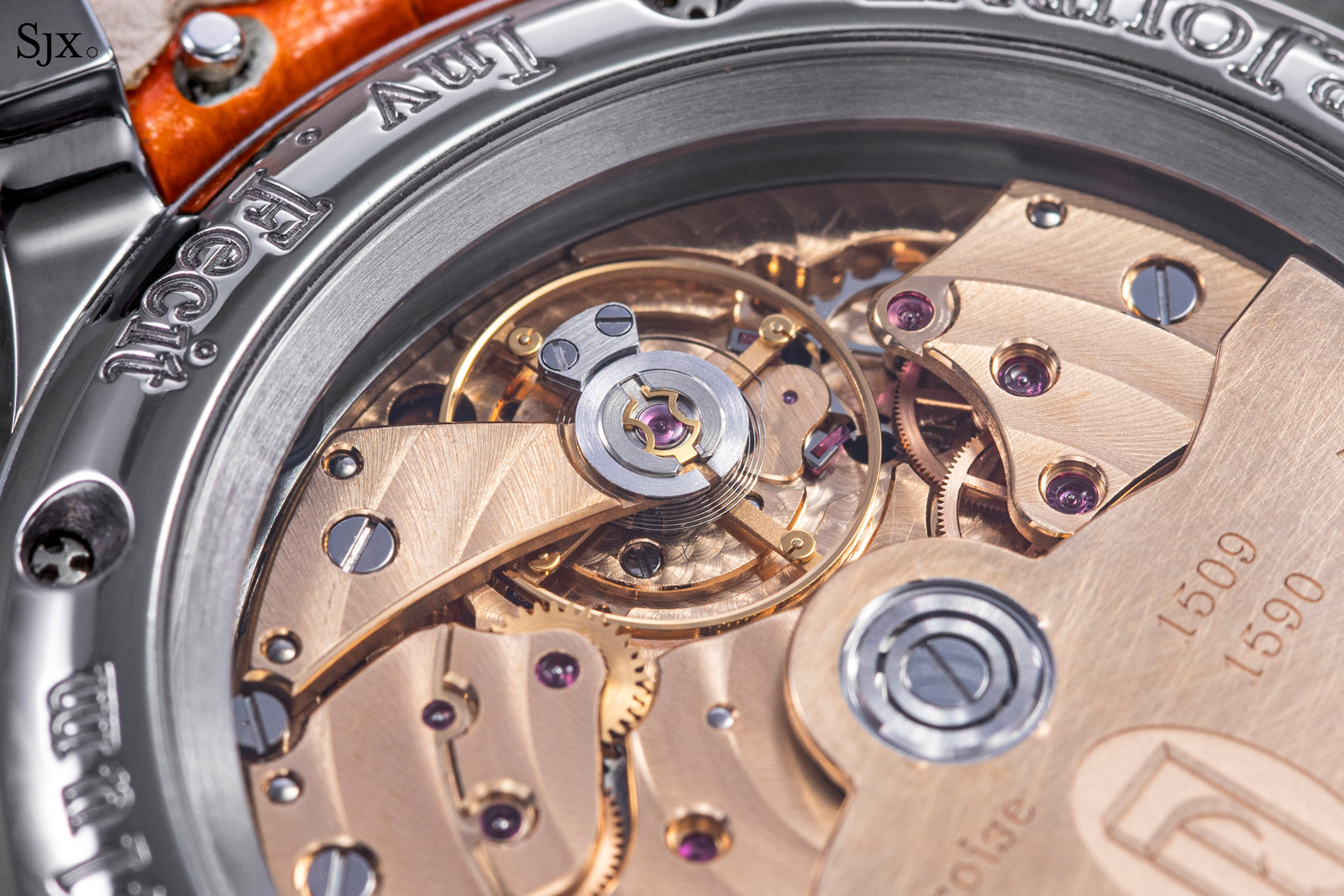
The four-armed, free-sprung balance
Size-wise the FFC Blue is identical to a typical 42 mm F.P. Journe wristwatch. And it is equally thin at 10.7 mm high.
And it also feels the same, because the case metal is comparable in density with the precious metals that are standard for F.P. Journe.
The case of the FFC Blue is tantalum, a dense bluish-grey metal that’s better known for being the case material of the Chronometre Bleu.
Paradoxically, and no double intentionally, the Chronometer Bleu was long the entry-level model in the F.P. Journe collection. But Mr Journe used the same metal – and dial colour – for all of his Only Watch creations to date. And the FFC Blue will no doubt become the most expensive F.P. Journe sold publicly once the hammer comes down.
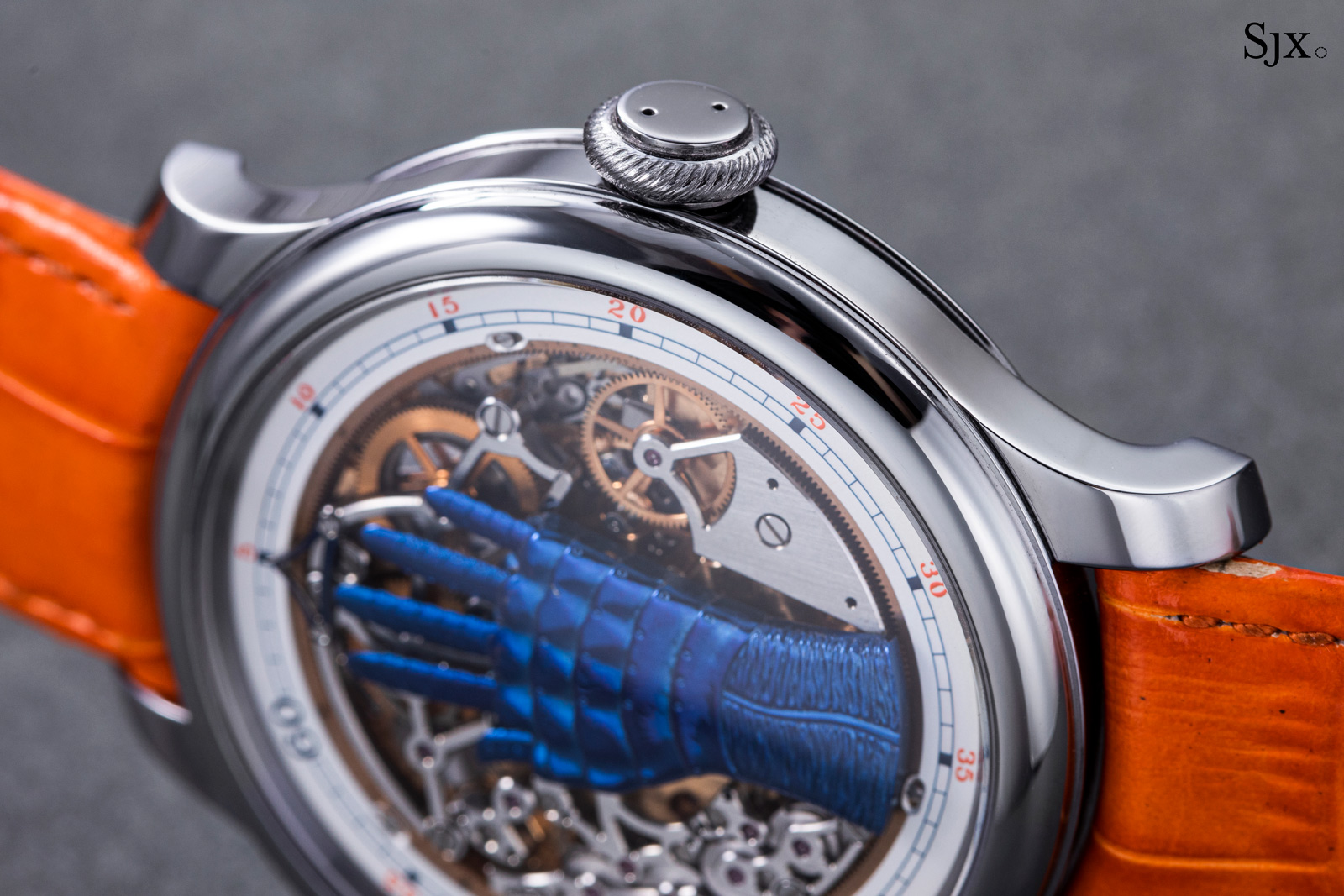
F.P. Journe FFC Blue
Ref. FFC
Diameter: 42 mm
Height: 10.70 mm
Material: Tantalum
Crystal: Sapphire
Water resistance: 30 m
Movement: Cal. 1300.3
Functions: Hours, minute
Additional features: Bridges and base plate in rose gold
Winding: Automatic
Frequency: 21,600 beats per hour (3 Hz)
Power reserve: Unavailable
Strap: Alligator strap
Limited edition: Unique piece
Availability: To be sold at Only Watch on November 6, 2021
Estimate: 300,000-400,000 Swiss francs
For more, visit Onlywatch.com.
Back to top.


